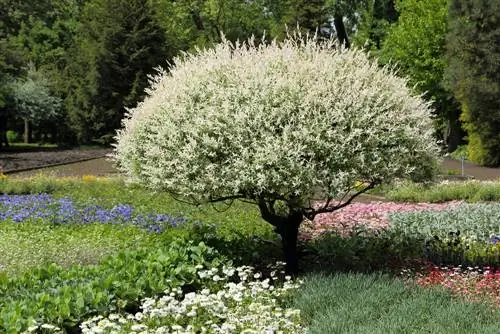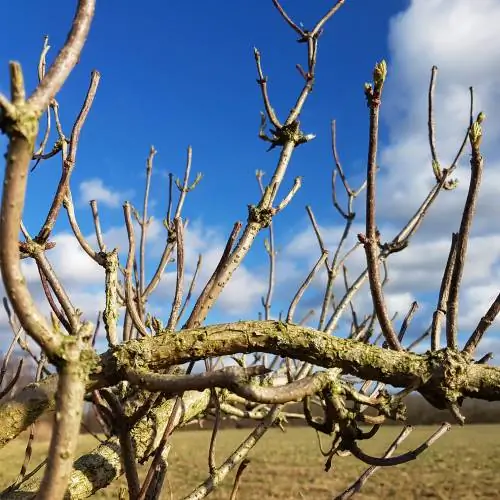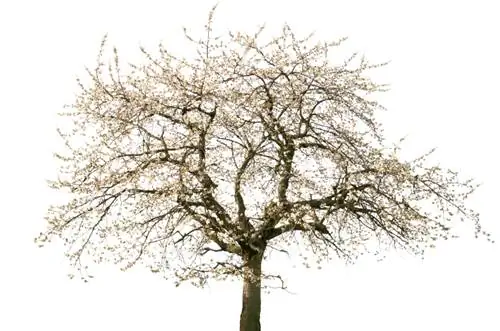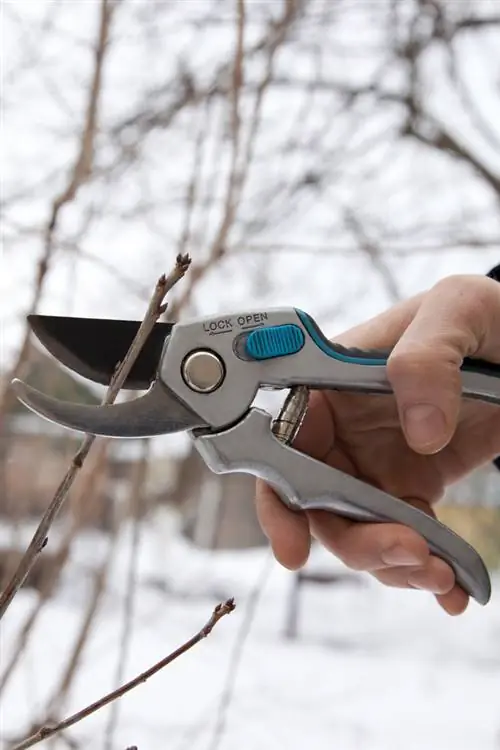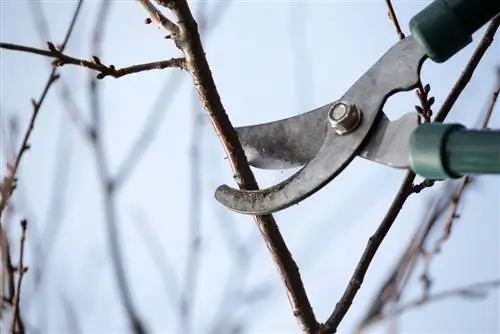- Author admin [email protected].
- Public 2023-12-24 06:09.
- Last modified 2025-06-01 06:02.
With a variegated foliage dress, the harlequin willow interprets the timeless phenomenon of the versatile, cheerfully colorful theater character. In fact, the name for the attractive ornamental tree could not have been chosen more appropriately. Because an ornamental willow 'Hakuro Nishiki' demonstrates timeless creativity as a decorative standard tree and shapely shrub in every garden. The most important prerequisite for a perfect appearance on the garden stage is proper pruning care. This tutorial will familiarize you with all the types of pruning that will give a harlequin willow its most beautiful foliage.
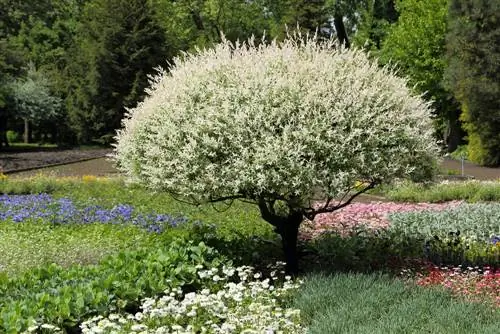
How should you prune the harlequin willow?
Cut the harlequin willow depending on the current weather. Shorten the crown shoots so that the willow has room for new growth. The optimal time for cutting is February. Choose a frost-free day.
Skillfully cutting the harlequin among the bushes - all types of cutting and dates
The multifaceted willow genus (Salix) provides home gardeners with the variegated variety 'Hakuro Nishiki', one of the most colorful ornamental trees for imaginative garden design. The gem is known under the name 'Harlequin willow' (Salix integra) and found its way from East Asia to our gardens in 1979. The appearance is characterized by white, pink and green colored leaves on yellowish to reddish branches. Following an inconspicuous catkin blossom from March to April, the pretty leaves sprout from the beginning of May.
On theyoung branchesthe colors of the leaves unfold in their most beautiful form. A pink-cream-colored leaf shoot is legendary, which from a distance looks as if the harlequin willow has bloomed. Consistent cutting is therefore the top priority in the uncomplicated care program. Regularly replacing perennial shoots with this year's shoots guarantees a never-ending, summery play of colors in the leaves. The following table summarizes for you which types of cutting are recommended for the harlequin willow as a standard tree and ornamental shrub:
| Cut style | Goal/Occasion | best date |
|---|---|---|
| Topiary tree trunk | Cut the crown, thin out dead wood | Late winter (January to early March) |
| Care cutting for tall stems | Crown shape preserved compact and variegated | End of June |
| Plant cuttings shrub | dense branching at the base | after planting |
| Pruning shrub | spherical, compact shrub shape, thin out dead wood, continuous rejuvenation | from the 3rd year in late winter (January to early March) |
| Care cutting shrub | opaque growth, well-groomed appearance | from the 3rd year at the end of June |
| Rejuvenating shrub | revitalizing aging harlequin willow | November to the end of February |
The current weather conditions are crucial when choosing a date for cutting your harlequin willow. Pruning care inFebruarycan be easily done on afrost-free, overcast dayIn summer, give preference to a warm, but not scorching hot day. Bright sun and drynessare the most importantExclusion criteria for the cutting time around St. John's Day.
Topiary pruning keeps the standard crown dense and colorful
On this year's shoots, a standard crown has the most colorful leaves. An annual pruning of the previous year's crown branches clears the way for fresh growth. How to cut correctly:
- The best time is in February, before budding begins
- Cut back all crown shoots except for short cones
- Place the scissors at a distance of 3 to 5 millimeters from a bud
By radically pruning the crown branches, you can cause strong new growth of young shoots. A supplementary supply of nutrients is beneficial for growth. After pruning, fertilize with compost and horn shavings. Harlequin willow in the bucket gratefully accepts a liquid fertilizer for green plants.
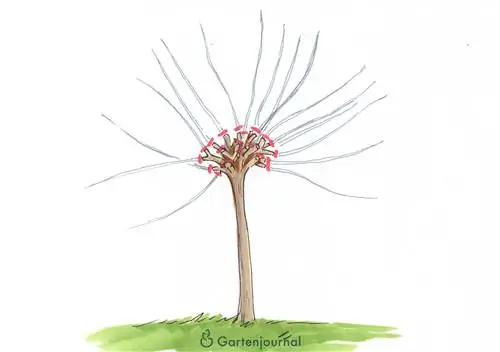
In early spring, in good time before new growth, cut back all the crown shoots of a harlequin willow down to short stubs.
Excursus
Cut harlequin willow with bypass or anvil shears?
Willow wood is very soft and therefore easy to cut. This feature makes pruning your harlequin willow simple and uncomplicated. Use one-handed pruning shears when cutting back the crown or shrub. Bypass scissors with two sharp blades are recommended for a smooth cut. With anvil scissors, there is a risk that the soft wood will get caught between the sharp blade and the dull anvil and fray.
High-stem crown benefits from summer care pruning
Thestrong topiary cutin February results in strong growth, which makes afurther cut in the summer sensible. To ensure that your harlequin willow thrives as a standard tree with a shapely and densely compact crown, use the scissors again around St. John's Day at the end of June. At this point the plants take a break in growth. This is followed by a second, weaker shoot with fresh, colorful decorative leaves. How to properly prune your Harlequin tree in summer:
- Cut back crown branches by a third or half
- Alternatively, just shorten branches that protrude from the crown shape
- Remove shoots sprouting from the trunk or root disc
High stems of a harlequin willow are grafted onto the trunk and rhizome of a robust wild species. As a result, lots of wild shoots sprout from the trunk or the root disk. Every wild shoot contains a vehement growth power that is superior to the branches of the noble crown. So that the wild shoots do not take over the growth and overgrow the noble part, they should be removed promptly. Follow the rule of thumb here: All shoots below the grafting point at the base of the crown must be removed as quickly as possible.
Background
Wide, spherical crown shape has many advantages
As a standard tree, the harlequin willow comes with a natural spherical crown. Pruning twice will make a significant contribution to ensuring that your tree maintains its advantageous crown shape. Round crowns guarantee an unhindered supply of light, so that photosynthesis can be carried out on all branches and twigs. This results in densely leafy growth from spring to autumn from the crown tip to the base of the trunk. Without cutting, the ornamental willow loses its harmonious spherical shape over the years and turns into a sprawling, flat-oval growth up to 200 centimeters wide, which is more reminiscent of a failed pancake.
Cutting harlequin willow as a shrub after planting - this is how it works
Planted out as a shrub in the bed, the harlequin willow is a true splendor. Ornamental willows naturally have a hemispherical habit with a height of up to 300 centimeters. As a solitary plant, decorative group or free-growing hedge, 'Hakuro Nishiki' attracts everyone's attention in small and large gardens. To ensure that harlequin willow bushes branch densely from the base to the top of the bush, a planting cut sets the course. This is how it works:
- The best time is immediately after planting
- Alternatively, do the planting cut in February of the following year
- Cut back bare-rooted young bushes by half
- Short young plants in pots or containers by a third
As the illustration below illustrates, expert plant pruning requires a radical approach. Don't let this confuse you. They cause sap to accumulate in the lower buds, which ensures strong branching at the base of the plant with a long-term effect.
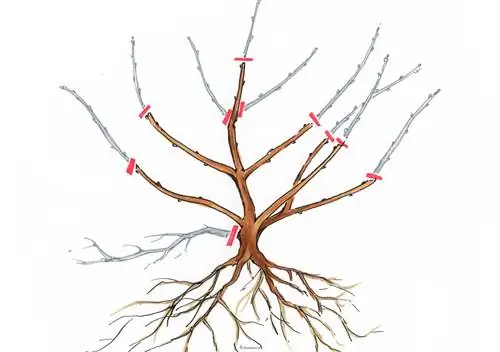
A planting cut guarantees that your harlequin willow will branch out lushly as a shrub. Cut back bare-rooted produce by half. Shorten a young bush in a pot or container by a third. A sap builds up on the lower buds, whereupon increased shoots begin at the base of the bush.
Excursus
High sap pressure stimulates bud growth
The decisive factor for the intensity of budding and growth is the sap pressure. Like most plant species, willows pump their juices vigorously and purposefully to the tip buds of their shoots. The reason for the floral strategy is to grow as quickly as possible towards sunlight so as not to be overshadowed by neighboring plants. The further down the position of a bud, the lower the sap pressure and growth. If you cut back the shoots during planting, previously subordinate buds take on the leading role and are given a correspondingly strong flow of sap. Since there are fewer buds to serve at the same time, the juice pressure on each remaining bud increases, whereupon vigorous budding begins.
For a shrub in top shape - shape and maintenance pruning
After pruning, allow a harlequin willow bush to grow for two to three years. Your ornamental willow completes the development phase to become a hemispherical shrub beauty without any horticultural intervention. Starting with the third year of growth, a shape and maintenance pruning guarantees youthful vitality and a colorful foliage. How to do it right:
- Best time is in February on a frost-free day
- Check the bush in advance for animal winter guests in order to reschedule the appointment if necessary
- Thin out dead branches at the base
- Do the same with criss-cross or inwardly growing shoots
Once dead wood and unfavorable branches have been removed, devote yourself to topiary. Do not cut back all shoots uniformly. To ensure that the beautiful, hemispherical shape is maintained, shorten external branches more. Overall, the shoots should be cut back by at least a third in order to promote the growth of young branches this year. A cut of up to two thirds is easily possible if you do not want a privacy function in the first few months of the gardening year. After cutting, fertilize with compost and horn shavings and water generously.
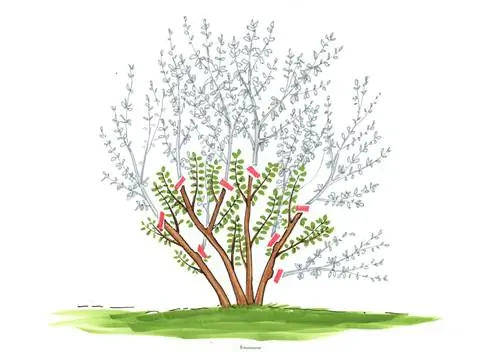
Prune back a harlequin willow bush heavily in February to encourage it to sprout young shoots with colorful leaves. Take this opportunity to thin out dead branches and awkward shoots for a harmonious, compact appearance.
Tip
Ornamental willow 'Hakuro Nishiki' is native to East Asia. Unlike native willow species, your harlequin willow cannot rely on a home advantage when it comes to disease resistance. Therefore, when cutting, pay strict attention to working withclean, disinfected blades. Pathogenic pathogens use unclean cutting tools as an ideal means of transport to cuts on trees.
Care cutting prevents the leaves from turning green in summer
A strong pruning in February is followed by a correspondingly strong sprouting of long, flexible branches with beautifully variegated leaves. As the summer progresses, the leaves on the harlequin willow bush visibly turn green. It is therefore an advantage if you prune again between the end of June and mid-July. How to proceed professionally:
- Examine the harlequin willow carefully for nesting birds in order to reschedule the appointment if necessary
- Cut off this year's growth with freshly sharpened, disinfected scissors
- Short shoots in the outside area more than shoots in the center of the bush
Please do not cut ornamental willow bushes in sweltering heat or during a summer drought. Ideally, choose a time with mild temperatures and overcast skies.
Background
Observe the summer grace period when pruning trees
This tutorial advocates moderate summer pruning of ornamental willows as shrubs and tall stems for three good reasons. If you cut back this year's growth on your harlequin willow on St. John's Day, a breath of fresh air will come into the leaf festival of colors. At the same time, you can support the compact, dense, bushy growth of the crown and bush with pruning. First and foremost, take urgent consideration for the breeding season of numerous bird species. The summer grace period is manifested in the Federal Nature Conservation Act from March 1st to September 30th. Moderate cutson trees are permitted as long as there areno nests in the branches.
Rejuvenate old harlequin bushes - clear the way for fresh colors
Without annual shape and maintenance pruning, a harlequin willow bush is only remotely reminiscent of the premium variety 'Hakuro Nishiki'. Rather, the tree presents itself as an impenetrable network of old and young shoots with uniformly green foliage. This is no reason to throw in the towel and clear the harlequin willow. Now you can benefit from the robustcutting tolerance. By placing the old bushon the stick, you clear the way for a new structure. This is how the plan works:
- The best time is between November and the end of February on a frost-free day
- First check the dense bushes for animal winter guests
- Saw dead wood until just above the ground
- Cut back remaining shoots to 20 or 30 centimeters
Direct the growth into the natural, hemispherical shape during the rejuvenation cut. For this purpose, shorten ground shoots inside the bush less than shoots outside. To promote branching from below, cut back the growth by half to two thirds at the end of June the following summer. We also recommend fertilizing twice at the beginning of March and the beginning of July with compost and horn shavings or an organic fertilizer from a specialist retailer.

The robust pruning tolerance of harlequin willows allows radical rejuvenation pruning. Shorten all shoots sharply back to two hand-widths above the ground. From the sleeping eyes the ornamental willow sprouts again.
Background
Putting on the stick activates sleeping buds
The categorization of harlequin willow as a tree that tolerates pruning is based primarily on its ability to sprout freshly from old wood. The floral masterpiece is successful because the plant produces dormant buds as it grows. These serve as a last resort if other parts of the plant fail, such as branches, twigs or the trunk. Technical jargon refers to the secret vegetation spots as sleeping eyes because they are located as tiny little points under the bark. By placing a harlequin willow bush (not the standard one!) on the cane during rejuvenation, sleeping buds are activated and guarantee that young shoots and leaves will sprout again.
Frequently asked questions
I would like to plant a deciduous hedge with a privacy function in the front garden. Is the harlequin willow suitable for this?
If you have a freely growing hedge in mind as a fence and privacy screen, the harlequin willow is ideal. With annual maintenance pruning in February and topiary pruning at the end of June, ornamental willows thrive compactly and opaquely during the summer. For a strictly formal hedge, you should use other deciduous trees, such as privet or hornbeam.
Which underplanting is suitable for the harlequin willow as a standard tree?
As a standard tree, the harlequin willow is refined into a robust type of willow, such as osier. Since all willows thrive as shallow-rooted plants, the appropriate underplanting should be low-competitive. Recommended are elf flowers (Epimedium), lady's mantle (Alchemilla), cranesbill (Geranium) and foam blossom (Tiarella).
lady's mantle, foam blossom or cranesbill
We planted our harlequin willow as a standard tree 2 years ago. When should the first pruning take place? What should you pay attention to?
The crown of a harlequin willow should be cut “hedgehog-short” every spring. The most colorful leaves form on young shoots. Over the course of the summer, you can trim the spherical crown into shape as desired or let it grow untrimmed. Please never cut the “Harlequin” ornamental willow in frost, heat or drought.
My ornamental willow 'Harlequin' is in the sunny front garden and suffers from numerous brown leaves. What can I do about it?
As an immediate measure, we recommend shading the crown, for example with a parasol. To ensure an adequate water supply, please check daily in the early morning in the summer using a finger test to see whether the soil is dry and should be watered. A slight pruning close to St. John's Day (June 24th) also contributes to solving the problem. Then add compost with horn shavings to give the suffering tree a helping hand.
On my 3 meter high 'Hakuro Nishiki' the leaves are turning brown and black. At the same time, hordes of ants are on the tree. What is missing from the plant?
If ants are in an ornamental pasture, lice are not far away. Ant workers give aphids piggyback rides, transporting them to the leaves and milking the honeydew the pests produce. Brown leaf discoloration indicates that lice are extracting the plant's sap. Sooty mold fungi are already spreading on black willow leaves, a common consequence of aphid infestation. Fight the aphids with a spray solution made from 1 liter of water, 2 tablespoons of pure soap and a splash of spirit. The ants then stay away from the place that is inhospitable to lice. Finally, cut all affected shoots back to he althy wood.
Shoots sprout from the grafted harlequin willow trunk. I will remove these wild shoots as soon as possible. What type of willow is the rootstock? Can I use the shoots as cuttings in the garden?
High-stem harlequin willows are usually grafted onto basket willow (Salix viminalis). The willow species is known for its strong branch growth of 100 to 200 centimeters per year and thrives in any normal garden soil. You can plant the trunk shoots as cuttings directly in the sunny to partially shaded bed to grow a willow bush or small tree.
The 3 most common cutting mistakes
Only annual pruning turns the harlequin willow into the floral light that makes gardeners' hearts beat faster. If shape and maintenance cuts are not made, the ornamental willow will age into an unsightly bush or disappoint with a misshapen crown and plain green leaves. To protect you from making mistakes when editing, we will name the three most common editing errors, point out typical damage and give tips for prevention:
| Cutting errors | malicious image | Prevention |
|---|---|---|
| High-stem crown never cut back | sprawling, misshapen crown, no variegated foliage color | Cut the crown back to short cones in February |
| Harlequin bush not thinned out | premature senescence, dense undergrowth as old and young branches | thin every late winter from the 3rd year onwards |
| no pruning | lack of pink-green shoots, low foliage color | Prune tall stems and shrubs at least once a year |
Another common mistake with fatal consequences results from confusing harlequin willow (Salix integra 'Hakuro Nishiki') with a hanging catkinse willow (Salix caprea 'Pendula'). The latter bears soft catkins as its most beautiful decoration from March to April. Therefore, the standard crown and bush are cut after the flowering period. Cutting in February would destroy all hopes of the silvery kittens.

Tip
Did you change the location of your harlequin willow in the bed within the first five years? Then the tree will forgive you the associated stress if you choose the leaf-free autumn period as the date. As shallow-rooted plants, tall stems and shrubs lose a lot of root mass when transplanted. Cut back an ornamental willow by at least half to restore balance between above-ground and below-ground growth.

